HDR10+
HDR10+[1] is a High Dynamic Range (HDR) video technology that adds dynamic metadata[2] to HDR10 source files. HDR10+ signals the dynamic range and scene characteristics on a scene-by-scene or even frame-by-frame basis. The display device then uses the dynamic metadata to apply an appropriate tone map through the process of dynamic tone mapping[3]. Dynamic tone mapping differs from static tone mapping by applying a different tone curve from scene-to-scene rather than use a single tone curve for an entire video.[4] HDR10+ is the default variant of dynamic metadata as part of the HDMI 2.1 standard (in Amendment 1 of it).
Workflow and ecosystem

HDR10+ utilizes an HDR10 master file within existing HDR post-production and distribution workflows.
The HDR10+ ecosystem is used within current systems by,
Metadata generation

For offline and Video-On-Demand (VOD) (e.g. Ultra-High Definition Blu-ray, Over-The-Top (OTT), Multi-Channel Video Programming Distributor (MVPD)), HDR10+ Metadata may be created during the post-production, mastering process or during transcoding/encoding for distribution back-ends by HDR10+ content generation tools in two steps,
- Identifying scene cuts, and
- Performing an image analysis on each scene or frame to derive statistics
HDR10+ metadata is interchanged through a low complexity JSON-structured text file[7], which is then parsed and injected into video files.
Live encoding

Live use cases are possible by delivering HDR10+ metadata in every frame. HEVC encoders generate and inject metadata on live content and mobile phones record video and create HDR10+[8] metadata in real-time during recording. Live encoding is detailed in the Live Encoder Workflow diagram and real time broadcast operations are supported at the point of transmission enabling a metadata-less broadcast operation.
Compatibility

HDR10+ metadata follows ITU-T T.35 and can co-exist with other HDR metadata such as HDR10 static metadata that makes HDR10+ content backward compatible[9] with non-HDR10+ TVs. HDR10+ metadata is ignored by devices that do not support the format and video is played back in HDR10.
HDR10+ content profile
- EOTF: SMPTE ST 2084 (PQ)
- Chroma Sub-sampling: 4:2:0 (for compressed video sources)
- Resolution: Agnostic (2K/4K/8K[10], etc.)
- Bit Depth: 10-bit or more (up to 16-bit)
- Color Primaries: ITU-R BT.2020
- Maximum linearized pixel value: 10,000 cd/m2 for each color R/G/B (content)
- Metadata (Required): Mastering Display Color Volume Metadata[11]
- Metadata (Optional): MaxCLL, MaxFALL[12]
HDR10+ technology can support the full range of HDR standards to 10,000 cd/m2, 8K and BT.2020 color gamut. Being resolution agnostic, metadata needs to be created only once and can be applied to any target resolution.
HDR10+ is applicable for HEVC and VP9 compatibility via WebM[13] as well as any codec that supports ITU-T T.35 metadata.
Administration

HDR10+ Technologies, LLC[14] administers the license and certification program for products that want to adopt HDR10+. HDR10+ Technologies, LLC provides the technical specifications, test specifications, and certified logo.
Authorized Test Centers
Certification of products is done through Authorized Test Centers. The following are a list of HDR10+ Authorized Test Centers,
Adopters[16]
HDR10+ certified products
Certified product[17] categories include:
- Ultra-High Definition displays
- Ultra-High Definition Blu-ray disc players
- Systems-on-chip (SoC)
- Set-top boxes
- A/V Receivers
- Streaming applications
- Mobile devices
References
- "What is HDR10+? What you need to know". Trusted Reviews. 2019-05-21. Retrieved 2019-09-16.
- "Understanding Dynamic Metadata". Creative Planet Network. 2016-11-30. Retrieved 2019-09-16.
- Werner, Ken (2017-02-16). "Two Keys to Optimal HDR TVs: Dynamic HDR Metadata and Tone Mapping". DisplayDaily. Retrieved 2019-09-16.
- "What is 4K HDR Dynamic Metadata?". AVForums. Retrieved 2019-11-19.
- "SEI messages | MPEG". mpeg.chiariglione.org. Retrieved 2019-09-05.
- Katzmaier, David. "Galaxy S10 screen deep dive: Dynamic AMOLED, HDR10+, explained". CNET. Retrieved 2019-09-16.
- "Transkoder 2018: User Guide". www.colorfront.com. Retrieved 2019-11-19.
- HDR10+ Video Recording on Your Galaxy S10, retrieved 2019-09-16
- "Are You Ready for Your HDR Delivery?". Studio Daily. 2018-12-19. Retrieved 2019-11-19.
- "Samsung brings its HDR10+ tech to 8K TVs". Engadget. Retrieved 2019-09-16.
- Mastering Display Color Volume Metadata Supporting High Luminance and Wide Color Gamut Images. doi:10.5594/SMPTE.ST2086.2018. ISBN 978-1-68303-139-0.
- Turner, Paul. "HDR: Standards, Standards, Everywhere". TvTechnology. Retrieved 2019-11-19.
- "The WebM Project | VP9 Video Codec Summary". www.webmproject.org. Retrieved 2019-09-05.
- "HDR10+".
- "HDR10+ Technologies, LLC, Founded by 20th Century Fox, Panasonic and Samsung, Welcomes First Adopters of HDR10+ Technology". www.businesswire.com. 2018-08-28. Retrieved 2019-09-05.
- "Adopters - HDR10+". hdr10plus.org. Retrieved 2019-09-05.
- "HDR10+ Certification Begins This Month, Brings the Tech to More TVS". www.digitaltrends.com. 2018-06-21. Retrieved 2019-09-16.